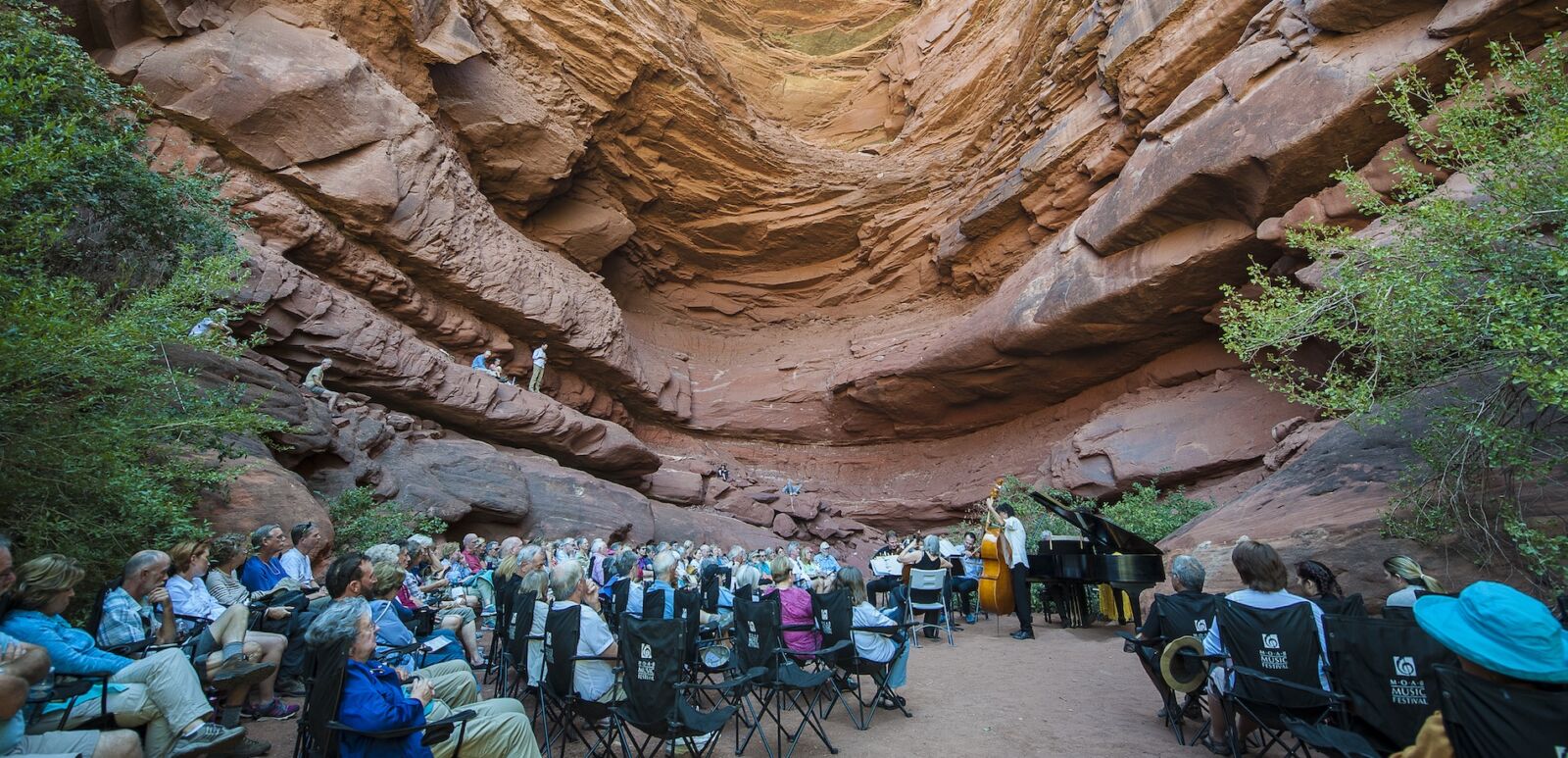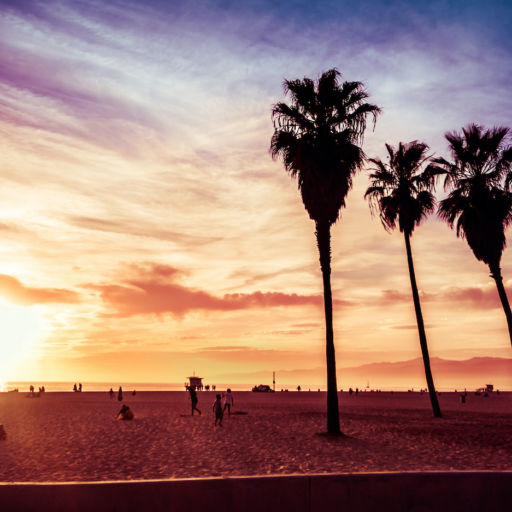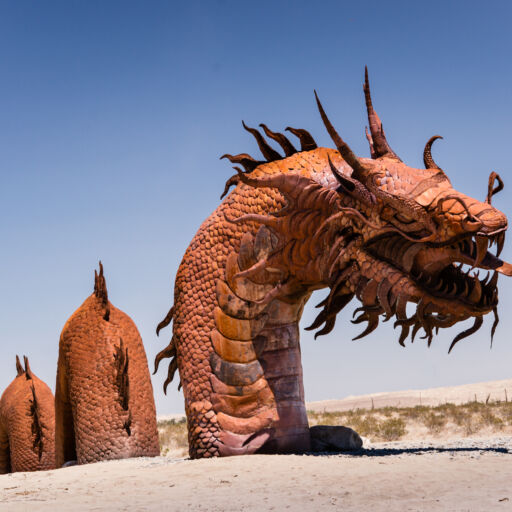The red walls of Canyonlands and Arches National Parks funneled us to each event of the Moab Music Festival, all staged in Moab, Utah and the nooks of the surrounding desert. On the first afternoon of the festival, the huge, imposing sandstone slabs framed the Colorado River as I made my way to one of the event’s biggest draws, “Grotto I: 19th Century Classics,” and rode on an airboat with about 30 other festival-goers.
For roughly half an hour, we motored along the walls, ribbed with fractures, as they narrowed and widened with the bends of the water, before we reached a slim break in the rock where the boat slowed to a halt. An enthusiastic man, who looked young for his age, 70, emerged to help us de-board. Somewhere behind me, I overheard one passenger comment to another, “He’s wearing his kilt again,” and, indeed, the man had on an old t-shirt tucked into a leather skirt. Many attendees come year after year, and these must be two of them.
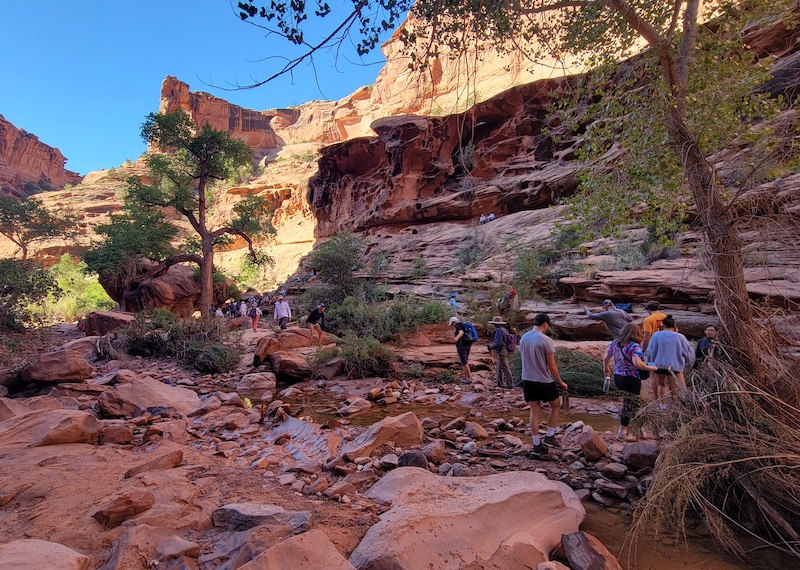
A Steinway piano made the exact same journey down the river before we arrived, deconstructed and wrapped in blankets on the bow of a boat. The waters were calm in this part of the river, but it was still a complicated feat: A flood right before the festival had altered the water level and reconfigured the shape of the bank, rendering the festival’s plans to hoist the piano onto the sand unusable.
After 32 years of hauling large instruments into remote desert locations, the festival’s crew has gotten used to contingency plans, however. I passed through a thicket of trees and saw the piano, safely delivered, black and shiny against the dirt, and flanked by music stands where cellos, violas and violins would assume their position.
The Moab Music Festival is built around chamber music, classical music played by small groups. Its founders, Leslie Tomkins and Michael Barrett, are both classical musicians themselves. Tomkins plays the viola, and has performed at Carnegie Hall, the Lincoln Center and Madison Square Garden. Barrett, a conductor and pianist, was previously the director of New York City’s Tisch Center for the Arts and the 92nd Street Y.
For nearly as long as the festival has existed, the duo has held concerts in this hidden, circular alcove, which the festival calls “the grotto.” Its sandstone walls look cyclonic, like someone pressed pause on a whirlpool, only to reveal Cynthia Phelps, the principal violist of New York Philharmonic, at the bottom of the vortex, instrument in hand and surrounded by a few dozen foldable camping chairs. At Grotto I, Phelps is joined by violinists Miclen LaiPeng, Geneva Lewis, Aubree Oliverson, Simone Porter; cellist Matthew Zalkind and Jay Campbell; and pianists Michael Stephen Brown and Derek Wang, all world-class musicians in their own right, and many of whom have performed at the festival before. I found a seat.
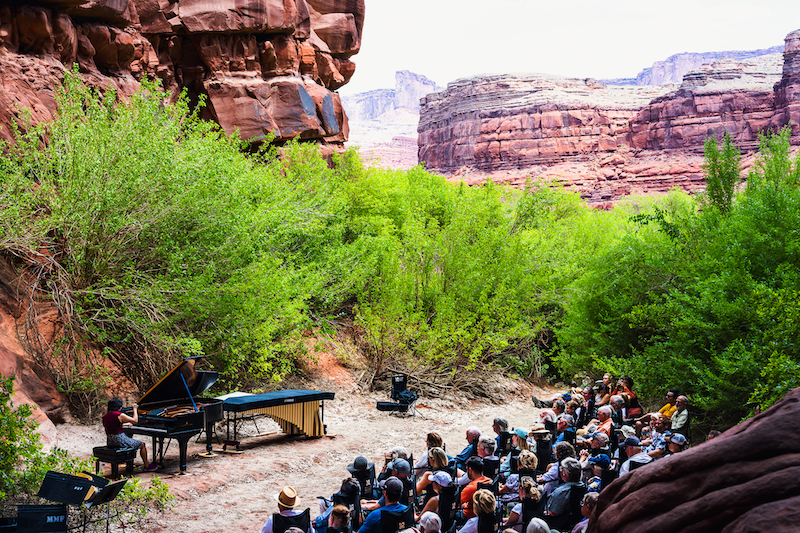
The idea to have a music festival reverberate against the fluctuating surfaces of a desert is, in a way, intuitive; anybody who’s walked into an open space, yelled out “hello!” and waited to hear how their voice echoes and changes, knows this. Tomkins and Barrett took this impulse to its logistical extreme. Chamber music is particularly sensitive to acoustics. Unlike say, rock n’ roll, which can use the artifacts of digital amplification to its advantage, chamber music benefits when it can produce a clear sound in silent space. The desert, and especially a place like the grotto, can achieve silence, so why not put a piano there?
Before the concert began, Barrett asked the audience to sit quietly for a full minute so they can experience what silence felt like. About five men scattered around the grotto struggled to stay still for the duration, and in the grotto, the sound traveled so well that I heard clothes rub against the cloth weave of the seats as they fidgeted. Then, the music began.
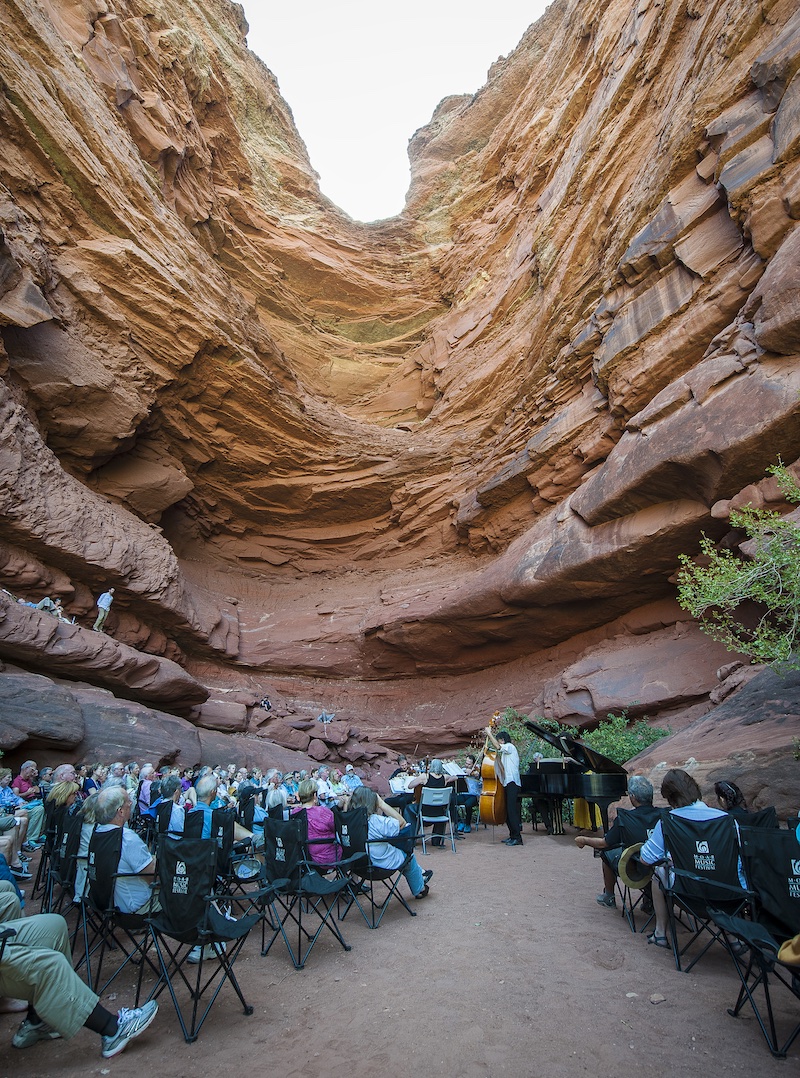
I am not the festival’s average patron, most of whom look well beyond retirement age and were able to chat easily about their favorite symphonies. I’m 29, among the youngest in attendance. I don’t regularly listen to classical music. This was my first time I heard the names Robert Schumann and Johannes Brahms, the composers who wrote the pieces performed that day.
In the grotto, however, my naivety didn’t matter; familiarity was besides the point. There was a gestalt to the experience. The music reached into the desert and the desert shaped the music, and together, they did something to me. By the end of the concert, I felt extremely relaxed, almost narcotized, like an infant swaddled in a blanket.
When Tomkins first visited Moab as a tourist, she says her entire body reacted to the desert. “There was just this sort of thing that I felt emanating into my body, and literally, resonating with my being. … I just wanted to be around it. I wanted to go back to it.” She founded the festival to give back to the desert “energetically,” in the form of music. The festival has grown from five events to 21 individually-ticketed events over two weeks, ranging from a riverside concert by the indie band Bailen, to the world premiere of compositions the festival commissions around a theme — this year, the Colorado River — to performances by the Hopi Nation.
Grotto I is among its most expensive, going for $490 a ticket, but there are more affordable options, like the music hikes, which cost around $80 a ticket. The latter is an easy add-on to any Labor Day weekend vacation in Moab, and you aren’t losing much at the cheaper price point. The acoustics may not be as crisp as in the grotto, but many of the same musicians perform at each event, and you still get the benefit of the desert.
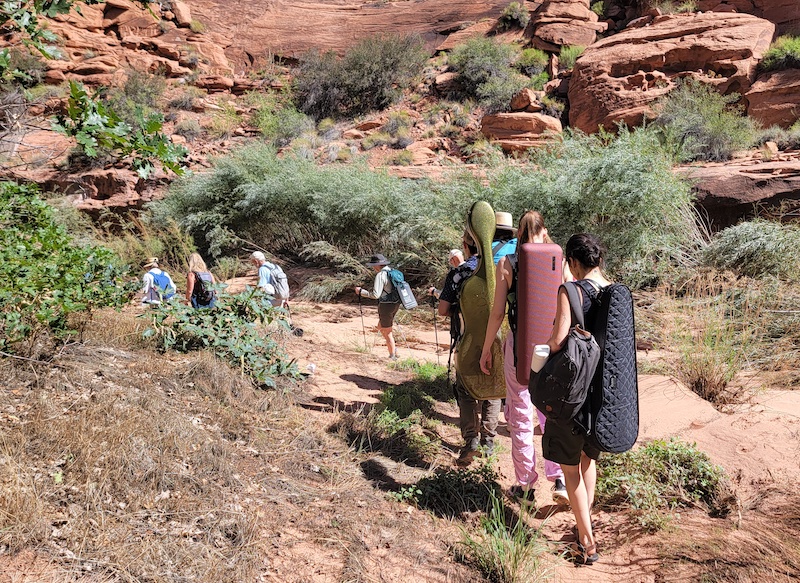
I attended a music hike on the first Saturday of the festival, which departed in a shuttle from Moab at around 7:45 a.m. and headed 30 minutes outside of town. The flood washed out the original hike trail, forcing the festival organizers to switch locations at the last minute. So, we walked a mile through a river bed, the water still trickling through and the red walls once again looming overhead, until we reached a sandstone arch that functioned like an acoustic shell.
The more spritely attendees clambered up to the rocks and made seats for themselves on the natural shelves in the wall. Others took to a large flat rock that extended across the riverbed and lounged on it like lizards basking in the sun, or found a spot in the dirt.
From where I sat, I saw the musicians waiting in the de facto green groom, an open space behind the arch on the opposite side of the water. When it was their time to play, they ducked under the short opening at the base of the arch and formed a semicircle with their instruments, which included cellos, violas, violins and clarinets. Some of them were barefoot.
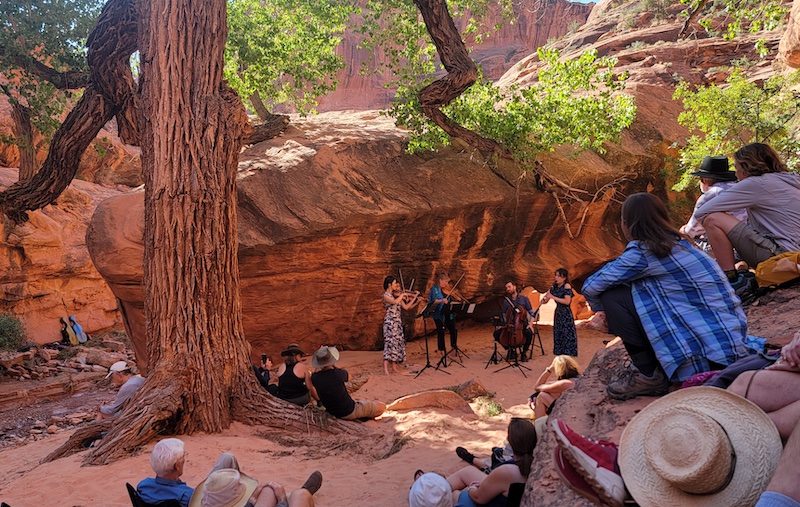
The performers did not know exactly what their instruments would sound like before they started playing. Their instruments are made of wood and the outdoor temperature can alter their tuning. Also, every edge of the desert shapes sound differently, so much so that where you sat at the music hike changed your experience of the concert.
“You’d have to travel country to country to find a variety of acoustics that are this good and this different,” the day’s cello player, Jay Campbell, said of Moab. “I feel pretty confident the best acoustics in the world, as far as I know, are here.”
The musicians took a moment to tune their instruments before the concert began. As the first few notes rang out, they looked at each other and laughed.


